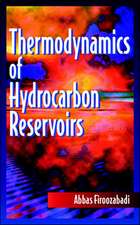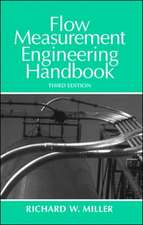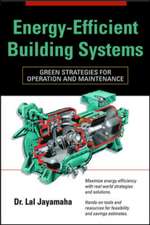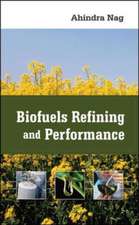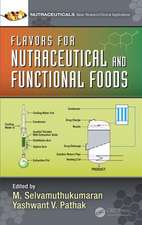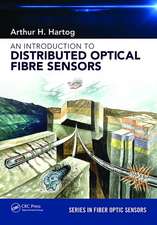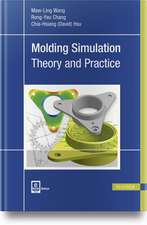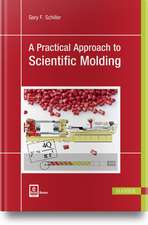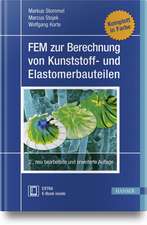Energy-Efficient Industrial Systems: Evaluation and Implementation
Autor Lal Jayamahaen Limba Engleză Hardback – 16 mai 2015
Publisher's Note: Products purchased from Third Party sellers are not guaranteed by the publisher for quality, authenticity, or access to any online entitlements included with the product.
Proven Solutions for Maximizing Energy Efficiency in Today’s Industrial Systems
This practical guide features ten self-contained chapters that thoroughly analyze each component in large-scale industrial facilities and lay out best practices for reducing energy consumption and optimizing performance. Designed to help minimize costs and comply with environmental regulations, Energy-Efficient Industrial Systems: Evaluation and Implementation clearly explains the elements of successful energy management programs and offers ready-to-implement strategies and techniques. Real-world case studies throughout illustrate successful projects that have achieved significant energy conservation results.
Energy-Efficient Industrial Systems: Evaluation and Implementation covers:
· Energy Management
· Motors and Drives
· Pumping Systems
Proven Solutions for Maximizing Energy Efficiency in Today’s Industrial Systems
This practical guide features ten self-contained chapters that thoroughly analyze each component in large-scale industrial facilities and lay out best practices for reducing energy consumption and optimizing performance. Designed to help minimize costs and comply with environmental regulations, Energy-Efficient Industrial Systems: Evaluation and Implementation clearly explains the elements of successful energy management programs and offers ready-to-implement strategies and techniques. Real-world case studies throughout illustrate successful projects that have achieved significant energy conservation results.
Energy-Efficient Industrial Systems: Evaluation and Implementation covers:
· Energy Management
· Motors and Drives
· Pumping Systems
Preț: 669.18 lei
Preț vechi: 974.57 lei
-31% Nou
Puncte Express: 1004
Preț estimativ în valută:
128.06€ • 133.53$ • 106.43£
128.06€ • 133.53$ • 106.43£
Carte disponibilă
Livrare economică 28 februarie-05 martie
Preluare comenzi: 021 569.72.76
Specificații
ISBN-13: 9781259589782
ISBN-10: 1259589781
Pagini: 288
Dimensiuni: 193 x 244 x 23 mm
Greutate: 0.71 kg
Editura: McGraw Hill Education
Colecția McGraw-Hill
Locul publicării:United States
ISBN-10: 1259589781
Pagini: 288
Dimensiuni: 193 x 244 x 23 mm
Greutate: 0.71 kg
Editura: McGraw Hill Education
Colecția McGraw-Hill
Locul publicării:United States
Cuprins
Abbreviations and Acronyms
1 Energy Management
1.1 Introduction
1.2 Main Drivers for Energy Management
1.3 Typical Energy Management Program
1.4 Energy Policy
1.5 Energy Management Team
1.6 Energy Manager
1.7 Energy Usage and Baseline Data
1.8 Energy Accounting Centers and EnPIs
1.9 Targets and Action Plans
1.10 Energy Audits
1.10.1 Level 1 Audit
1.10.2 Level 2 Audit
1.10.3 Level 3 Audit
1.11 Training
1.12 Awareness
1.13 Documentation
1.14 Internal Audit
1.15 Management Review
2 Motors and Drives
2.1 Introduction to Motors
2.1.1 AC Induction Motors
2.1.2 DC Motors
2.1.3 Permanent-Magnet Motors
2.1.4 Synchronous Motors
2.2 Speed of Motors
2.3 Slip in Motors
2.4 Motor Efficiency
2.5 Losses in Motors
2.6 High-Efficiency Motors
2.7 Impact of Motor Loading on Efficiency
2.8 Estimating Motor Loading
2.8.1 Input Method
2.8.2 Slip Method
2.9 Economics of Energy-Efficient Motors
2.10 Input Power Supply to Motors
2.10.1 Input Power
2.10.2 Supply Voltage
2.10.3 Power Factor
2.11 Maintenance of Motors
2.11.1 Lubrication
2.11.2 Cleaning
2.11.3 Motor Temperature
2.11.4 Voltage Testing
2.11.5 Insulation Testing
2.11.6 Vibration
2.11.7 Alignment
2.12 Motor Drives
2.12.1 Couplings
2.12.2 Belt Drives
2.12.3 Gear Drives
2.13 Variable-Frequency Drives
2.13.1 Introduction
2.13.2 Components of a VFD
2.13.3 Features of VFDs
2.13.4 Selection and Installation
3 Pumping Systems
3.1 Types of Pumps
3.2 System and Pump Curves
3.3 Pump Power
3.4 Affinity Laws
3.5 Pressure Losses in Pipes and Fittings
3.6 Parallel and Series Pumping
3.7 Pump Sizing
3.8 Constant-Flow versus Variable-Flow Systems
3.9 Effect of Pump Speed and Size on Efficiency
3.10 Avoiding Use of Bypass Systems
3.11 Use of Small Pumps to Augment Larger Pumps
3.12 Designing to Minimize Pressure Losses
3.13 Pump Efficiency
3.14 Overall Efficiency
3.14.1 Constant-Speed Pumps
3.14.2 Variable-Speed Pumps
4 Fan Systems
4.1 Types of Fans
4.2 Fan and System Characteristics
4.3 Fan Selection
4.4 Theoretical Fan Power Consumption
4.5 Affinity Laws
4.6 System Losses
4.7 Fan Discharge and Inlet System Effects
4.8 Filter Losses
4.8.1 Face Velocity
4.9 Coil Losses
4.9.1 Clean Coils
4.9.2 Face Velocity
4.10 Fan Efficiency
4.11 Right Sizing of Fans
4.12 Modulating Airflow Rate
5 Boilers and Steam Systems
5.1 Introduction
5.2 Fundamentals of Steam
5.2.1 Dryness Fraction of Steam
5.2.2 Sensible Heat of Water
5.2.3 Latent Heat of Water
5.2.4 Total Enthalpy of Steam
5.2.5 Steam Tables
5.3 Boilers
5.4 Boiler Efficiency
5.4.1 Combustion Efficiency
5.4.2 Thermal Efficiency
5.4.3 Overall Efficiency
5.5 Energy-Saving Measures for Boiler Systems
5.5.1 Improving Combustion Efficiency
5.5.2 Steam Pressure
5.5.3 Optimizing Operation of Auxiliary Equipment
5.5.4 Standby Losses
5.5.5 Minimizing Conduction and Radiation Losses
5.5.6 Heat Recovery from Flue Gas
5.5.7 Flash Steam Recovery
5.5.8 Automatic Blowdown Control
5.5.9 Heat Recovery from Blowdown
5.5.10 Condensate Recovery
5.5.11 Steam Traps
5.5.12 Steam Leaks
5.5.13 Feedwater Tank
5.5.14 Fouling and Scaling in Boilers
6 Process Cooling Systems
6.1 Introduction
6.2 Once-Through Systems
6.3 Cooling Tower Systems
6.3.1 Energy-Saving Measures for Cooling Tower Systems
6.4 Low-Temperature Cooling Systems
6.4.1 Energy-Saving Measures for Low-Temperature Cooling Systems
6.5 Refrigeration Systems
6.5.1 Energy-Saving Measures for Refrigeration Systems
7 Compressed Air Systems
7.1 Introduction
7.2 Typical System Components
7.3 Free Air Delivery
7.4 Standard Con
1 Energy Management
1.1 Introduction
1.2 Main Drivers for Energy Management
1.3 Typical Energy Management Program
1.4 Energy Policy
1.5 Energy Management Team
1.6 Energy Manager
1.7 Energy Usage and Baseline Data
1.8 Energy Accounting Centers and EnPIs
1.9 Targets and Action Plans
1.10 Energy Audits
1.10.1 Level 1 Audit
1.10.2 Level 2 Audit
1.10.3 Level 3 Audit
1.11 Training
1.12 Awareness
1.13 Documentation
1.14 Internal Audit
1.15 Management Review
2 Motors and Drives
2.1 Introduction to Motors
2.1.1 AC Induction Motors
2.1.2 DC Motors
2.1.3 Permanent-Magnet Motors
2.1.4 Synchronous Motors
2.2 Speed of Motors
2.3 Slip in Motors
2.4 Motor Efficiency
2.5 Losses in Motors
2.6 High-Efficiency Motors
2.7 Impact of Motor Loading on Efficiency
2.8 Estimating Motor Loading
2.8.1 Input Method
2.8.2 Slip Method
2.9 Economics of Energy-Efficient Motors
2.10 Input Power Supply to Motors
2.10.1 Input Power
2.10.2 Supply Voltage
2.10.3 Power Factor
2.11 Maintenance of Motors
2.11.1 Lubrication
2.11.2 Cleaning
2.11.3 Motor Temperature
2.11.4 Voltage Testing
2.11.5 Insulation Testing
2.11.6 Vibration
2.11.7 Alignment
2.12 Motor Drives
2.12.1 Couplings
2.12.2 Belt Drives
2.12.3 Gear Drives
2.13 Variable-Frequency Drives
2.13.1 Introduction
2.13.2 Components of a VFD
2.13.3 Features of VFDs
2.13.4 Selection and Installation
3 Pumping Systems
3.1 Types of Pumps
3.2 System and Pump Curves
3.3 Pump Power
3.4 Affinity Laws
3.5 Pressure Losses in Pipes and Fittings
3.6 Parallel and Series Pumping
3.7 Pump Sizing
3.8 Constant-Flow versus Variable-Flow Systems
3.9 Effect of Pump Speed and Size on Efficiency
3.10 Avoiding Use of Bypass Systems
3.11 Use of Small Pumps to Augment Larger Pumps
3.12 Designing to Minimize Pressure Losses
3.13 Pump Efficiency
3.14 Overall Efficiency
3.14.1 Constant-Speed Pumps
3.14.2 Variable-Speed Pumps
4 Fan Systems
4.1 Types of Fans
4.2 Fan and System Characteristics
4.3 Fan Selection
4.4 Theoretical Fan Power Consumption
4.5 Affinity Laws
4.6 System Losses
4.7 Fan Discharge and Inlet System Effects
4.8 Filter Losses
4.8.1 Face Velocity
4.9 Coil Losses
4.9.1 Clean Coils
4.9.2 Face Velocity
4.10 Fan Efficiency
4.11 Right Sizing of Fans
4.12 Modulating Airflow Rate
5 Boilers and Steam Systems
5.1 Introduction
5.2 Fundamentals of Steam
5.2.1 Dryness Fraction of Steam
5.2.2 Sensible Heat of Water
5.2.3 Latent Heat of Water
5.2.4 Total Enthalpy of Steam
5.2.5 Steam Tables
5.3 Boilers
5.4 Boiler Efficiency
5.4.1 Combustion Efficiency
5.4.2 Thermal Efficiency
5.4.3 Overall Efficiency
5.5 Energy-Saving Measures for Boiler Systems
5.5.1 Improving Combustion Efficiency
5.5.2 Steam Pressure
5.5.3 Optimizing Operation of Auxiliary Equipment
5.5.4 Standby Losses
5.5.5 Minimizing Conduction and Radiation Losses
5.5.6 Heat Recovery from Flue Gas
5.5.7 Flash Steam Recovery
5.5.8 Automatic Blowdown Control
5.5.9 Heat Recovery from Blowdown
5.5.10 Condensate Recovery
5.5.11 Steam Traps
5.5.12 Steam Leaks
5.5.13 Feedwater Tank
5.5.14 Fouling and Scaling in Boilers
6 Process Cooling Systems
6.1 Introduction
6.2 Once-Through Systems
6.3 Cooling Tower Systems
6.3.1 Energy-Saving Measures for Cooling Tower Systems
6.4 Low-Temperature Cooling Systems
6.4.1 Energy-Saving Measures for Low-Temperature Cooling Systems
6.5 Refrigeration Systems
6.5.1 Energy-Saving Measures for Refrigeration Systems
7 Compressed Air Systems
7.1 Introduction
7.2 Typical System Components
7.3 Free Air Delivery
7.4 Standard Con

